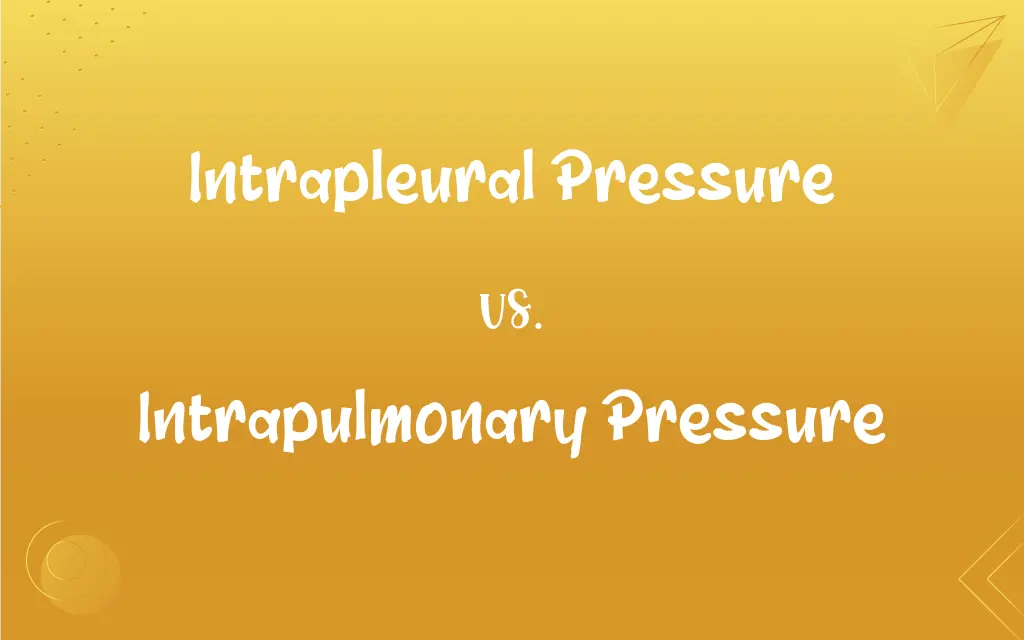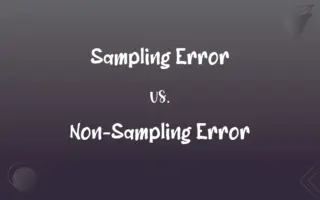Intrapleural Pressure vs. Intrapulmonary Pressure: What's the Difference?
Edited by Aimie Carlson || By Janet White || Published on February 15, 2024
Intrapleural pressure is the pressure within the pleural cavity, often negative; intrapulmonary pressure is the pressure within the lungs, equalizing with atmospheric pressure.

Key Differences
Intrapleural pressure refers to the pressure within the pleural cavity, the thin fluid-filled space between the lung and chest wall. In contrast, intrapulmonary pressure is the pressure within the airways and alveoli of the lungs, directly involved in the process of breathing.
Normally, intrapleural pressure is slightly negative, which helps keep the lungs expanded. Intrapulmonary pressure, on the other hand, varies during the respiratory cycle, becoming positive or negative relative to atmospheric pressure during exhalation or inhalation.
The difference in pressure between intrapleural and intrapulmonary pressures is critical for lung mechanics, influencing lung expansion and contraction. Intrapulmonary pressure must equalize with atmospheric pressure for air to flow in or out of the lungs.
Intrapleural pressure can become positive in pathological conditions, like pneumothorax, impacting lung function. Changes in intrapulmonary pressure are essential for normal breathing, but abnormalities can indicate respiratory disorders like asthma or COPD.
Comparison Chart
Location
Pressure within the pleural cavity
Pressure within the airways and alveoli of the lungs
ADVERTISEMENT
Normal Pressure Range
Slightly negative relative to atmospheric pressure
Varies, but equalizes with atmospheric pressure
Role in Breathing
Keeps lungs expanded
Allows air to flow in and out of the lungs
Changes During Breathing Cycle
Remains relatively constant compared to intrapulmonary pressure
Varies significantly during inhalation and exhalation
Clinical Significance
Abnormalities can lead to lung collapse (pneumothorax)
Abnormalities can indicate respiratory disorders
Intrapleural Pressure and Intrapulmonary Pressure Definitions
Intrapleural Pressure
A measurement important in respiratory physiology.
Intrapleural pressure becomes less negative during exhalation.
ADVERTISEMENT
Intrapulmonary Pressure
Equalizes with atmospheric pressure at rest.
At the end of each breath, intrapulmonary pressure returns to atmospheric levels.
Intrapleural Pressure
Key factor in preventing lung collapse.
Pneumothorax occurs when intrapleural pressure equals atmospheric pressure.
Intrapulmonary Pressure
The pressure within the lungs' airways and alveoli.
Intrapulmonary pressure rises above atmospheric pressure during exhalation.
Intrapleural Pressure
Influenced by chest wall and lung elasticity.
Intrapleural pressure is maintained by the balance of forces in the thoracic cavity.
Intrapulmonary Pressure
Indicator of airway resistance and lung compliance.
High intrapulmonary pressure can signal an obstructed airway.
Intrapleural Pressure
The pressure within the pleural space surrounding the lungs.
A negative intrapleural pressure is essential for lung expansion.
Intrapulmonary Pressure
Critical for airflow in and out of the lungs.
Breathing in occurs when intrapulmonary pressure drops below atmospheric pressure.
Intrapleural Pressure
Changes slightly during normal breathing.
During inhalation, the intrapleural pressure decreases.
Intrapulmonary Pressure
Changes markedly during the respiratory cycle.
Intrapulmonary pressure fluctuates with each breath.
FAQs
What is intrapulmonary pressure?
It's the pressure within the airways and alveoli of the lungs.
How does intrapleural pressure aid in breathing?
It helps keep the lungs expanded due to its slightly negative pressure.
Is intrapleural pressure always negative?
Yes, under normal conditions, it's slightly negative.
What can cause intrapleural pressure to become positive?
Conditions like pneumothorax can increase it to become positive.
What is intrapleural pressure?
It's the pressure within the pleural cavity between the lung and chest wall.
What indicates a problem with intrapulmonary pressure?
Abnormal values can indicate respiratory issues like asthma or COPD.
Does intrapulmonary pressure equalize with atmospheric pressure?
Yes, it equalizes with atmospheric pressure at the end of each breath.
What happens to intrapulmonary pressure during inhalation?
It decreases, allowing air to flow into the lungs.
How does intrapulmonary pressure change during exhalation?
It increases, pushing air out of the lungs.
Can intrapleural pressure become equal to atmospheric pressure?
In abnormal conditions like pneumothorax, it can.
What role does intrapulmonary pressure play in lung mechanics?
It facilitates the flow of air in and out of the lungs.
What happens if intrapleural pressure is not maintained?
It can lead to lung collapse or impaired lung function.
Why does intrapulmonary pressure vary?
It changes due to lung volume variations during breathing.
How is intrapleural pressure measured?
It's typically inferred from other measurements, not directly measured.
How do lung diseases affect intrapulmonary pressure?
They can alter resistance and compliance, affecting pressure.
What is the significance of negative intrapleural pressure?
It's essential for keeping the lungs open and functioning.
Can intrapleural pressure change with lung diseases?
Yes, diseases can affect the pressure and lung function.
What is the relationship between intrapleural and intrapulmonary pressure?
Their interaction is key to effective lung expansion and contraction.
What happens to intrapulmonary pressure during deep breathing?
It fluctuates more significantly during deep breaths.
Is monitoring intrapleural pressure important in medicine?
Yes, it's crucial for assessing and managing chest injuries and diseases.
About Author
Written by
Janet WhiteJanet White has been an esteemed writer and blogger for Difference Wiki. Holding a Master's degree in Science and Medical Journalism from the prestigious Boston University, she has consistently demonstrated her expertise and passion for her field. When she's not immersed in her work, Janet relishes her time exercising, delving into a good book, and cherishing moments with friends and family.
Edited by
Aimie CarlsonAimie Carlson, holding a master's degree in English literature, is a fervent English language enthusiast. She lends her writing talents to Difference Wiki, a prominent website that specializes in comparisons, offering readers insightful analyses that both captivate and inform.































































